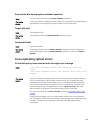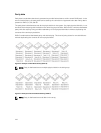
10
Appendix: RAID description
RAID is a group of independent physical disks that provides high performance by increasing the number
of disks used for saving and accessing data.
CAUTION: In the event of a physical disk failure, a RAID 0 virtual disk fails, resulting in data loss.
A RAID disk subsystem offers the following benefits:
• Improved I/O performance and data availability.
• Improved data throughput because several disks are accessed simultaneously. The physical disk group
appears either as a single storage unit or multiple logical units to the host system.
• Improved data storage availability and fault tolerance. Data loss caused by a physical disk failure can
be recovered by rebuilding missing data from the remaining physical disks containing data or parity.
Summary of RAID levels
Following is the RAID levels supported by PERC 9 series of cards:
• RAID 0 uses disk striping to provide high data throughput, especially for large files in an environment
that requires no data redundancy.
• RAID 1 uses disk mirroring so that data written to one physical disk is simultaneously written to
another physical disk. RAID 1 is good for small databases or other applications that require small
capacity and complete data redundancy.
• RAID 5 uses disk striping and parity data across all physical disks (distributed parity) to provide high
data throughput and data redundancy, especially for small random access.
• RAID 6 is an extension of RAID 5 and uses an additional parity block. RAID 6 uses block-level striping
with two parity blocks distributed across all member disks. RAID 6 provides protection against double
disk failures, and failures while a single disk is rebuilding. If you are using only one array, deploying
RAID 6 is more effective than deploying a hot spare disk.
• RAID 10 is a combination of RAID 0 and RAID 1, uses disk striping across mirrored disks. It provides
high data throughput and complete data redundancy.
• RAID 50 is a combination of RAID 0 and RAID 5 where a RAID 0 array is striped across RAID 5
elements. RAID 50 requires at least six disks.
• RAID 60 is a combination of RAID 0 and RAID 6 where a RAID 0 array is striped across RAID 6
elements. RAID 60 requires at least eight disks.
RAID terminology
Disk striping
Disk striping allows you to write data across multiple physical disks instead of just one physical disk. Disk
striping involves partitioning each physical disk storage space in stripes of the following sizes: 64 KB, 128
112


















